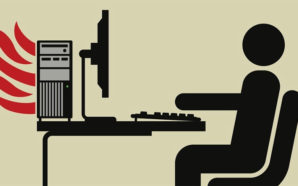Tekken is as recognisable a name as Final Fantasy, Pokémon or Street Fighter. Hailing from the golden age of Japanese video games, Tekken games continue to be amongst the most successful titles of the genre thanks to more than fortunate timing and nostalgia. It remains because of its evolution. Two decades on, Katsuhiro Harada continues delivering the smoothest and most accessible fighting game on the market. Tekken welcomes the newcomer. Tekken welcomes the seasoned vet. With the latest iteration, Tekken 7: Fated Rebirth, recently releasing on consoles and PC, here’s a look at how Tekken’s gameplay has changed over the series’ lifespan.
Dawn of the Iron Fist
The original Tekken game hit the Japanese arcades in 1994 and the homes of Western players in 1995. It was the first PlayStation game to sell a million copies and its success was down to more than Harada’s marketing skills. A title unique within its genre, Tekken slowed the action down in contrast to other fighting games. Think of playing Tekken like fighting in a heightened state of consciousness. Imagine you’re able to react quicker and your body flows in a rhythm. The rhythm of you beating your opponent into a pulp. This is the case because of frames of animation: Tekken uses a lot more of them than most fighting games. More frames make for smoother moves. For its day, Tekken is John Travolta in Saturday Night Fever smooth. However, much like John Travolta, Tekken’s moves fail to make the same impact today.
The other thing that made Tekken unique was its button mapping. Most fighting games have buttons corresponding to the strength of a move with Light, Medium and Strong Punches and Kicks. Namco instead opted to have a button per limb with Right and Left Punches and Kicks. This meant that all moves were intuitive and easy to learn by watching, a natural evolution for the genre. If you see a low-aimed punch with the left arm, chances are you can pull it off by pressing Down and Left Punch buttons together. Thanks to this, combos can easily be strung together with classic one-two punches and punch-kick combinations. Not only were these intuitive but also realistic. The game won acclaim among martial artists thanks to the in-game fighters’ styles being very similar to real-world ones.

Kazuya: Tekken 1 versus Tekken 7
Tekken 2: First Signs of Evolution
Tekken 2 entered the Japanese arcades three months before Kazuya took his revenge on Heihachi in our Western homes. It brought the players a few new mechanics and new characters. The most significant mechanic making a debut was the now beloved auto-guard system. This caused a character standing still or crouching to automatically block incoming attacks accordingly. This means, vitally, that if a player sees their attacks being blocked they simply refrain from input to ensure their character blocks at the next possible moment. Patience made up for lack of experience. Tekken 2’s Kazuya also brought us the first hint of fully utilising the 3D space with a side-stepping move where he blends into the background for a moment. This signature move remains in Kazuya’s repertoire today and everybody else gets to use the third dimension with him.
Tekken 3: New King of Iron Fist
In March 1997, two years after Kazuya had been dumped into a volcano, his son Jin came to claim his father’s throne. Tekken 3 released to great critical acclaim and sold over 8 million copies worldwide. The critics hailed Tekken 3 as the greatest fighting game and for good reason, too. Firstly, the game took new, uncharted steps towards realism. Not only were its graphics cutting edge but mechanically the game took leaps and bounds. Or realistic hops. Jumping was toned down to a realistic(ish) height and replaced with side-stepping as a form of defence. The third Tekken had entered the third dimension completely and it was glorious.
The biggest step was, however, in response time. Suddenly, you have characters reacting almost instantly to button presses. A golden standard that the franchise would maintain. Namco added a host of new three and four hit combos to complement this responsiveness. 1997 saw the smoothest 3D fighting game of all time. Furthermore, by mapping buttons to limbs, the team created a unique player-character relationship. A symbiotic one. Natural. Here, we reach a point where the character feels like an extension of the player. Organic gameplay. Still regarded as one of the greatest of all time, Tekken 3 is the pinnacle of 3D fighting games.

Credit: https://i.ytimg.com/vi/rhnww9-ZbjQ/maxresdefault.jpg
Tekken Games Enter a New Generation
Tekken Tag Tournament hit the arcades shortly before the release of the Playstation 2, which it was eventually ported onto. One major feature from Tekken Tag remains today: Rage. Back then, it was called Netsu Power and worked a little differently. Instead of your active character becoming stronger, their tag partner built up rage for their beaten up friend. About a year after Tag, Harada and his Namco team learned their hardest lesson. Featuring a new engine, Tekken 4 truly brought the franchise into the new generation of consoles.
The Iron Fist tournament now had interactive and destructible stages. If a player found themselves pinned in a corner by a ruthless vet, the corner would often collapse and open the stage back up. The new engine wasn’t faultless, however, and Namco faced a backlash from its competitive players. Because of its pioneering nature, a few bugs slipped through the cracks. Hit detection was off and Tekken had lost its trademark – suddenly speed was everything.
And then a hero comes along. Tekken 5 and its ingenious Crush System. Again, we see speed beaten by tactical awareness. Jumping attacks automatically avoiding low hits and ducking attacks avoiding higher hits simply made sense. It was a natural evolution. If you had just joined us and wasn’t sure you could keep up with the big boys, you were handed intuitive and practical defences. Namco didn’t hide this information. No, this was plain to see and ACCESSIBLE.
A New Age For Fighting Games
In 2006, Sony changed the world with its revolutionary Playstation 3 console. Three years later, Tekken 6 ported onto the new beast. The sixth instalment saw some of the most drastic and important steps in the franchise’s evolution. Namco updated every character’s animations and made all jabs 10 frames long. This is a fundamental step in creating a level playing field. With every jab at 10 frames, no one character was faster or slower than another. Well, except for the big man, Ganryu, with 12 frames.
At this point in time, Tekken had developed a strong reputation for a button mashing game. Mostly thanks to the simple to use and flashy Eddy Gordo. Therefore, the team elected to reward high skill players by creating a juggle system. This meant that an opponent launched into the air and defenceless could be bounced off the ground on their way down and continue to be hit for massive damage. All the while moves remained simple with no more than a simple directional press coupled with a limb button. As such, new players weren’t required to learn long and complicated button sequences to string powerful combos. This promoted skill over experience.
Late into Playstation 3’s lifespan, Namco released the highly anticipated sequel to Tekken Tag Tournament. TTT2 revamped the Tag format by adding tag combos. Not only could you juggle your opponent by bouncing them off the ground, you could bounce them and switch into a fresh character for an even longer combo! Sounds like high-level stuff, though, right? Not exactly. An added layer of flair and damage was complimented by extended health bars. And thus Tekken continued to welcome all challengers.
Is This Even My Final Form Yet?

Credit: bandainamcoent-store.com
Here we are now, in 2017, and Namco has released the most noob-friendly fighting game outside of DiveKick. New additions include deeper rage mechanics, Power Crushers and, astonishingly, Story Assist. Story Assist is an accessibility feature whereby the game picks four powerful special moves and enables the player to perform them using one button. These aren’t just random cool moves, either. There is normally a Power Crusher, a Launch and a Screw.
Power Crushers are moves that continue even if the character is being hit. You still take damage from the incoming attacks but with great Crushers comes great Power. Launches are self-explanatory but Screws let you hit your opponent towards the ground to continue punishing them. Thereby, players have instant access to key moves. There is no need to study every moves list and again, skill is promoted over experience. Another step in its evolution, it adapts to a time where most of us don’t have any.
And there we have it: the Tekken franchise has been committed to giving new players an experience that isn’t overwhelming. It also continues to give us an experience that is smooth and responsive. We have come from three hit combos and visible input lag to complex juggles and seamless gameplay. What could Namco have in store for us next? How can they possibly make Tekken even simpler to use and even more impressive to master? What is the next stage of its evolution? Leave us a comment with your idea. Who knows where Harada-san’s eyes will reach…









